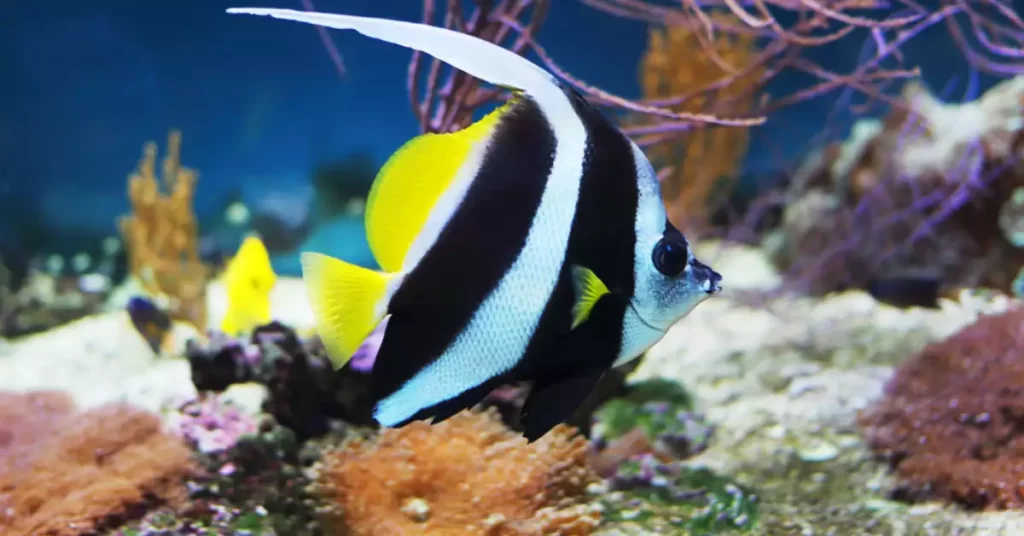Have you ever wondered if fish can see out of water? As fascinating creatures, fish have evolved a variety of features to navigate their aquatic environment.
This article delves into the intricacies of fish vision and how it functions above and below the water’s surface.
By the end, you’ll have a better understanding of these extraordinary creatures and their unique visual adaptations.
Fish Anatomy and Vision
Eye Structure
To comprehend how fish perceive their surroundings, it’s crucial to examine the structure of their eyes.
Similar to other vertebrates, fish possess a cornea, lens, iris, and retina. However, their eyes are specifically adapted to work in water, a medium that has a different refractive index than air.
Differences in Fish Eye Types
Fish eyes come in various shapes and sizes, reflecting their diverse habitats and lifestyles.
Some species have large, spherical lenses that enable them to see objects at a distance, while others have smaller, flatter lenses for improved close-range vision.
Fish that live in darker environments often have larger eyes to capture more light, while those inhabiting bright environments have smaller eyes to reduce glare.
How Fish See Underwater
Light Refraction and Absorption
Fish vision relies on the way light behaves underwater. As light penetrates water, it refracts, or bends, which can distort the image perceived by the fish.
Furthermore, water absorbs different wavelengths of light, resulting in a loss of color perception at greater depths.
Color Perception
Fish possess cones in their retinas, allowing them to perceive color. However, the range of colors they can detect depends on the specific species and the environment they inhabit.
Fish living in shallow, brightly lit waters tend to see a broader spectrum of colors, while those in deeper, darker waters may have more limited color perception.
Fish Vision Above Water
Light Refraction Differences
As fish are adapted to see underwater, their vision is affected when exposed to air.
When light transitions from air to water or vice versa, it refracts differently, causing images to appear distorted. Consequently, fish may struggle to see clearly when looking out of water.
Impact on Color Perception
The shift in light refraction also impacts a fish’s color perception above water.
Colors that are vivid underwater may appear washed out or altered when viewed in the air, making it difficult for fish to recognize the world above the surface accurately.

Fish Adaptations for Seeing Out of Water
Some fish species have evolved remarkable adaptations to help them see above water:
Anableps (Four-Eyed Fish)
Anableps, commonly known as the four-eyed fish, have eyes that are split horizontally, allowing them to see both above and below the water simultaneously.
This unique adaptation helps them avoid predators and locate food.
Archerfish
The archerfish is known for its ability to shoot water at insects above the surface.
To accurately target its prey, the archerfish has evolved a specialized vision that compensates for light refraction at the air-water interface.
Mudskippers
Mudskippers are amphibious fish that spend much of their time out of water.
Their eyes are capable of functioning both underwater and on land, and they can even move their eyes independently to observe their surroundings more effectively.
Do Fish Recognize the World Above the Surface?
Although most fish have limited vision above water, they are still capable of recognizing the world around them to some extent.
Fish can detect movements and changes in light, which can help them react to potential threats or opportunities.
Some fish, like the previously mentioned archerfish and mudskippers, have evolved specialized adaptations that enable them to interact with the environment above water more effectively.
How Does Water Affect Fish Vision?
Water can have a significant impact on fish vision, altering their perception of color, light, and depth.
In addition to the changes in light refraction and absorption, water clarity and turbidity can also influence a fish’s ability to see.
Murky water can reduce visibility, while clearer water allows for better light penetration and improved vision.
Comparing Fish Vision to Human Vision
Fish vision differs significantly from human vision, particularly when it comes to perceiving the world above water.
While humans have adapted to seeing in the air, fish are specialized for underwater vision.
Consequently, they may struggle to see clearly or accurately perceive colors when looking out of water.
Additionally, some fish have unique adaptations that allow them to see in conditions that would be challenging for humans, such as low-light environments or at the air-water interface.
FAQs
Can fish see in the dark?
Some fish species can see in low-light conditions or even complete darkness. They typically have larger eyes and more rod cells in their retinas, which are sensitive to low light levels.
Do all fish have the same vision capabilities?
No, fish vision varies depending on the species and their specific habitat. Some fish have better color perception, while others are adapted for low-light environments or seeing above water.
Do fish see in color?
Yes, many fish can perceive color, as they have cone cells in their retinas. However, the range of colors they can detect depends on the species and their environment.
Conclusion
Fish are fascinating creatures with a diverse range of visual adaptations suited to their underwater world.
Although their vision is primarily adapted for underwater use, some species have evolved unique features that allow them to see above the water’s surface.
While they may not perceive the world above water in the same way humans do, their specialized vision plays a crucial role in their survival and success in their aquatic environment.